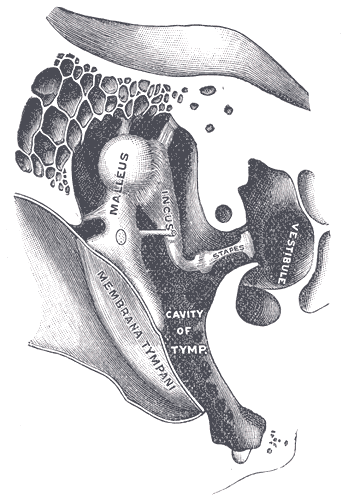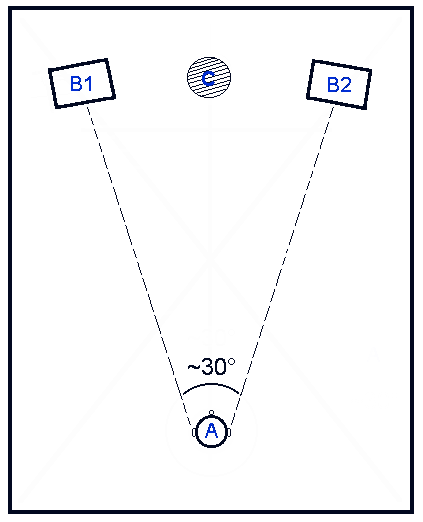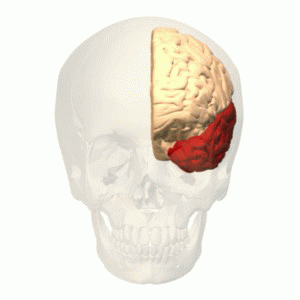|
Hearing
Hearing, or auditory perception, is the ability to perceive sounds through an organ, such as an ear, by detecting vibrations as periodic changes in the pressure of a surrounding medium. The academic field concerned with hearing is auditory science. Sound may be heard through solid, liquid, or gaseous matter. It is one of the traditional five senses. Partial or total inability to hear is called hearing loss. In humans and other vertebrates, hearing is performed primarily by the auditory system: mechanical waves, known as vibrations, are detected by the ear and transduction (physiology), transduced into nerve impulses that are perceived by the brain (primarily in the temporal lobe). Like touch, audition requires sensitivity to the movement of molecules in the world outside the organism. Both hearing and touch are types of mechanosensation. Hearing mechanism There are three main components of the human auditory system: the outer ear, the middle ear, and the inner ear. Outer ... [...More Info...] [...Related Items...] OR: [Wikipedia] [Google] [Baidu] |
Hearing Loss
Hearing loss is a partial or total inability to hear. Hearing loss may be present at birth or acquired at any time afterwards. Hearing loss may occur in one or both ears. In children, hearing problems can affect the ability to acquire spoken language, and in adults it can create difficulties with social interaction and at work. Hearing loss can be temporary or permanent. Hearing loss related to age usually affects both ears and is due to cochlear hair cell loss. In some people, particularly older people, hearing loss can result in loneliness. Hearing loss may be caused by a number of factors, including: genetics, ageing, exposure to noise, some infections, birth complications, trauma to the ear, and certain medications or toxins. A common condition that results in hearing loss is chronic ear infections. Certain infections during pregnancy, such as cytomegalovirus, syphilis and rubella, may also cause hearing loss in the child. Hearing loss is diagnosed when hearing ... [...More Info...] [...Related Items...] OR: [Wikipedia] [Google] [Baidu] |
Cochlea
The cochlea is the part of the inner ear involved in hearing. It is a spiral-shaped cavity in the bony labyrinth, in humans making 2.75 turns around its axis, the modiolus (cochlea), modiolus. A core component of the cochlea is the organ of Corti, the sensory organ of hearing, which is distributed along the partition separating the fluid chambers in the coiled tapered tube of the cochlea. Etymology The name 'cochlea' is derived from the Latin word for ''snail shell'', which in turn is from the Greek language, Ancient Greek κοχλίας ''kokhlias'' ("snail, screw"), and from κόχλος ''kokhlos'' ("spiral shell") in reference to its coiled shape; the cochlea is coiled in mammals with the exception of monotremes. Structure The cochlea (: cochleae) is a spiraled, hollow, conical chamber of bone, in which waves propagate from the base (near the middle ear and the oval window) to the apex (the top or center of the spiral). The spiral canal of the cochlea is a section of the b ... [...More Info...] [...Related Items...] OR: [Wikipedia] [Google] [Baidu] |
Auditory System
The auditory system is the sensory system for the sense of hearing. It includes both the ear, sensory organs (the ears) and the auditory parts of the sensory system. System overview The outer ear funnels sound vibrations to the eardrum, increasing the sound pressure in the middle frequency range. The Middle ear, middle-ear ossicles further amplify the vibration pressure roughly 20 times. The base of the stapes couples vibrations into the cochlea via the oval window, which vibrates the perilymph liquid (present throughout the inner ear) and causes the round window to bulb out as the oval window bulges in. Vestibular duct, Vestibular and tympanic ducts are filled with perilymph, and the smaller cochlear duct between them is filled with endolymph, a fluid with a very different ion concentration and voltage. Vestibular duct perilymph vibrations bend organ of Corti outer cells (4 lines) causing prestin to be released in cell tips. This causes the cells to be chemically elongated an ... [...More Info...] [...Related Items...] OR: [Wikipedia] [Google] [Baidu] |
Auditory Science
Auditory science or hearing science is a field of research and education concerning the Hearing, perception of sounds by humans, animals, or machines. It is a heavily interdisciplinary field at the crossroad between acoustics, neuroscience, and psychology. It is often related to one or many of these other fields: psychophysics, psychoacoustics, audiology, physiology, otorhinolaryngology, speech science, automatic speech recognition, music psychology, linguistics, and psycholinguistics. History Early auditory research included the early 19th century work of Georg Ohm and August Seebeck and their experiments and arguments about Fourier analysis of sounds. Later in the 19th century, German physicist Hermann von Helmholtz wrote ''Sensations of Tone'' describing the founding concepts of psychoacoustics, i.e. the relationship between the physical parameters of a sound and the percept that it induces. Psychoacoutics is primarily interested in the basic workings of the ear and is, the ... [...More Info...] [...Related Items...] OR: [Wikipedia] [Google] [Baidu] |
Sense
A sense is a biological system used by an organism for sensation, the process of gathering information about the surroundings through the detection of Stimulus (physiology), stimuli. Although, in some cultures, five human senses were traditionally identified as such (namely Visual perception, sight, Olfaction, smell, Somatosensory system, touch, taste, and hearing), many more are now recognized. Senses used by non-human organisms are even greater in variety and number. During sensation, sense organs collect various stimuli (such as a sound or smell) for Transduction (physiology), transduction, meaning transformation into a form that can be understood by the brain. Sensation and perception are fundamental to nearly every aspect of an organism's cognition, behavior and thought. In organisms, a sensory organ consists of a group of interrelated Sensory neuron, sensory cells that respond to a specific type of physical stimulus. Via Cranial nerves, cranial and spinal nerves (nerves ... [...More Info...] [...Related Items...] OR: [Wikipedia] [Google] [Baidu] |
Cerumen
Earwax, also known by the medical term cerumen, is a waxy substance secreted in the ear canal of humans and other mammals. Earwax can be many colors, including brown, orange, red, yellowish, and gray. Earwax protects the skin of the human ear canal, assists in cleaning and lubrication, and provides protection against bacteria, fungus, fungi, particulate matter, and water. Major components of earwax include Ceruminous gland, cerumen, produced by a type of Ceruminous gland, modified sweat gland, and Sebaceous gland, sebum, an oily substance. Both components are made by glands located in the ear canal, outer ear canal. The chemical composition of earwax includes Saturated fat, saturated and Unsaturated fat, unsaturated Fatty acid#Length of free fatty acid chains, long chain fatty acids, alcohols, squalene, and cholesterol. Earwax also contains Desquamation, dead Keratinocyte, skin cells and hair. Excess or compacted cerumen is the buildup of ear wax causing a blockage in the ear c ... [...More Info...] [...Related Items...] OR: [Wikipedia] [Google] [Baidu] |
Sound
In physics, sound is a vibration that propagates as an acoustic wave through a transmission medium such as a gas, liquid or solid. In human physiology and psychology, sound is the ''reception'' of such waves and their ''perception'' by the brain. Only acoustic waves that have frequency, frequencies lying between about 20 Hz and 20 kHz, the audio frequency range, elicit an auditory percept in humans. In air at atmospheric pressure, these represent sound waves with wavelengths of to . Sound waves above 20 kHz are known as ultrasound and are not audible to humans. Sound waves below 20 Hz are known as infrasound. Different animal species have varying hearing ranges, allowing some to even hear ultrasounds. Definition Sound is defined as "(a) Oscillation in pressure, stress, particle displacement, particle velocity, etc., propagated in a medium with internal forces (e.g., elastic or viscous), or the superposition of such propagated oscillation. (b) Auditory sen ... [...More Info...] [...Related Items...] OR: [Wikipedia] [Google] [Baidu] |
Vertical Sound Localization
Sound localization is a listener's ability to identify the location or origin of a detected sound in direction and distance. The sound localization mechanisms of the mammalian auditory system have been extensively studied. The auditory system uses several cues for sound source localization, including time difference and level difference (or intensity difference) between the ears, and spectral information. Other animals, such as birds and reptiles, also use them but they may use them differently, and some also have localization cues which are absent in the human auditory system, such as the effects of ear movements. Animals with the ability to localize sound have a clear evolutionary advantage. How sound reaches the brain Sound is the perceptual result of mechanical vibrations traveling through a medium such as air or water. Through the mechanisms of compression and rarefaction, sound waves travel through the air, bounce off the pinna and concha of the exterior ear, and ent ... [...More Info...] [...Related Items...] OR: [Wikipedia] [Google] [Baidu] |
Tensor Tympani Muscle
The tensor tympani is a muscle within the middle ear, located in the bony canal above the bony part of the auditory tube, and connects to the malleus bone. Its role is to dampen loud sounds, such as those produced from chewing, shouting, or thunder. Because its reaction time is not fast enough, the muscle cannot protect against hearing damage caused by sudden loud sounds, like explosions or gunshots, however some individuals have voluntary control over the muscle, and may tense it pre-emptively. Structure The tensor tympani is a muscle that is present in the middle ear. It arises from the cartilaginous part of the auditory tube, and the adjacent great wing of the sphenoid. It then passes through its own canal, and ends in the tympanic cavity as a slim tendon that connects to the handle of the malleus. The tendon makes a sharp bend around the ''processus cochleariformis'', part of the wall of its cavity, before it joins with the malleus. The tensor tympani receives blood from th ... [...More Info...] [...Related Items...] OR: [Wikipedia] [Google] [Baidu] |
Brain
The brain is an organ (biology), organ that serves as the center of the nervous system in all vertebrate and most invertebrate animals. It consists of nervous tissue and is typically located in the head (cephalization), usually near organs for special senses such as visual perception, vision, hearing, and olfaction. Being the most specialized organ, it is responsible for receiving information from the sensory nervous system, processing that information (thought, cognition, and intelligence) and the coordination of motor control (muscle activity and endocrine system). While invertebrate brains arise from paired segmental ganglia (each of which is only responsible for the respective segmentation (biology), body segment) of the ventral nerve cord, vertebrate brains develop axially from the midline dorsal nerve cord as a brain vesicle, vesicular enlargement at the rostral (anatomical term), rostral end of the neural tube, with centralized control over all body segments. All vertebr ... [...More Info...] [...Related Items...] OR: [Wikipedia] [Google] [Baidu] |
Temporal Lobe
The temporal lobe is one of the four major lobes of the cerebral cortex in the brain of mammals. The temporal lobe is located beneath the lateral fissure on both cerebral hemispheres of the mammalian brain. The temporal lobe is involved in processing sensory input into derived meanings for the appropriate retention of visual memory, language comprehension, and emotion association. ''Temporal'' refers to the head's temples. Structure The temporal lobe consists of structures that are vital for declarative or long-term memory. Declarative (denotative) or explicit memory is conscious memory divided into semantic memory (facts) and episodic memory (events). The medial temporal lobe structures are critical for long-term memory, and include the hippocampal formation, perirhinal cortex, parahippocampal, and entorhinal neocortical regions. The hippocampus is critical for memory formation, and the surrounding medial temporal cortex is currently theorized to be critical f ... [...More Info...] [...Related Items...] OR: [Wikipedia] [Google] [Baidu] |
Stapedius Muscle
The stapedius is the smallest skeletal muscle Skeletal muscle (commonly referred to as muscle) is one of the three types of vertebrate muscle tissue, the others being cardiac muscle and smooth muscle. They are part of the somatic nervous system, voluntary muscular system and typically are a ... in the human body. At just over one millimeter in length, its purpose is to stabilize the smallest bone in the body, the stapes or stirrup bone of the middle ear. Structure The stapedius emerges from a pinpoint foramen or opening in the apex of the pyramidal eminence (a hollow, cone-shaped prominence in the posterior wall of the tympanic cavity), and inserts into the neck of the stapes. Nerve supply The stapedius is supplied by the nerve to stapedius, a branch of the facial nerve. Function The stapedius dampens the vibrations of the stapes by pulling on the neck of that bone. As one of the muscles involved in the acoustic reflex it prevents excess movement of the stapes, helping to ... [...More Info...] [...Related Items...] OR: [Wikipedia] [Google] [Baidu] |







